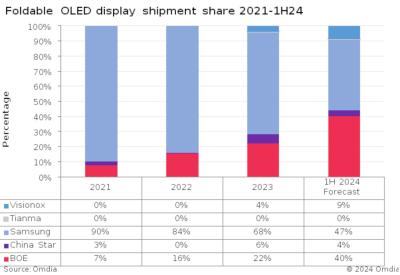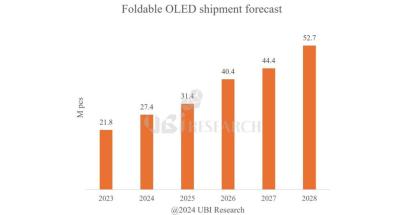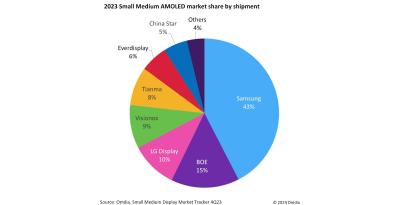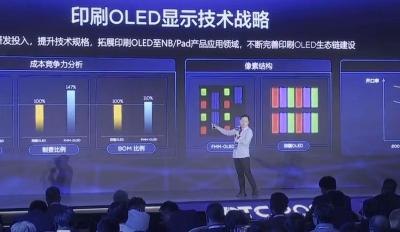Omdia estimates that China's foldable OLED panel production will surpass Korea's in H1 2024
Omdia says that China's OLED makers have been making rapid progress with their foldable OLED capabilities, to the point that in the first half of 2024, China's production of foldable OLED panels will surpass Korea's.
Omdia predicts that in the first half of 2024, Samsung Display will produce 5.7 million panels, while China's producers will produce 6.4 million panels. The market is set to grow quickly, from 10.7 million units in 2021 to 30 million panels in 2024. The market leader remains Samsung (47% in 2024H1), followed by BOE (40%), Visionox (9%) and TCL CSoT (4%).
TCL CSOT shows its latest OLED, MicroLED and QD-EL displays at Displayweek 2024
TCL CSOT demonstrated its latest displays, technologies and prototypes at Display Week 2024. The company is focused on inkjet printing technologies, and a lot of the displays on show were indeed printed.
So first up, we TCL demonstrated a 14" 2880x1800 400 nits 30-120Hz ink-jet printed LTPO AMOLED display. The display is produced on a glass substrate, with thin film encapsulation (a 'hybrid OLED').
TCL CSoT denies reports of a $8.7 billion investment in a new 8-Gen AMOLED fab
As OLED display makers are racing to launch IT AMOLED displays (for laptops, monitors and tablets), there has been recent reports that TCL CSoT has decided to build a 8-Gen AMOLED line, in a 63 billion Yuan (about $8.7 billion USD) investment.
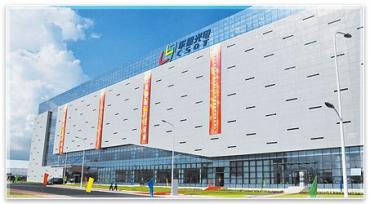
TCL CSoT issued a statement that says that this report is inaccurate, and the company has not made a decision yet and does not have an investment plan.
China's small-to-medium OLED production surpasses Korea's for the first time
According to Sino Research, in the first quarter of 2024, small-to-medium AMOLED production in China surpassed the production in Korea, by shipments, for the first time. China's market share was 53.9%, an increase from 44.9% in Q4 2023.
The leading producer is still Samsung Display, with a 41% market share (down from 53.3% last year). BOE has a market share of 17%, Visionox 12%, CSoT 10%, Tianma 9% and LGD 6%. The mean reason for the rise in China production and a decline in Korea's is lower shipments to Apple and an increase in the adoption of OLEDs in Chinese smartphones.
UBI: the foldable OLED market will grow to 52.7 million units in 2028, Samsung Display to remain the market leader
UBI Research released its latest foldable OLED shipments forecast, saying that it expects the market to grow from 27.4 million units in 2024 to 52.7 million 2028.
The market is dominated by Samsung Display, which shipped 13.4 million foldable OLEDs in 2023, and holds a 61% market. Samsung is followed by BOE (6.2 million, growing 3X from 2022), TCL CSOT (1.1 million) and Visionox (1.1 million). UBI expects Samsung Display to remain the clear leader in this market as it is the sole supplier to Samsung Electronics - and it is also expected that Samsung will be the exclusive supplier to Apple's future foldable iPhones.
Omdia: Samsung leads the small and medium AMOLED market with a 43% market share in 2023
Omdia released its small and medium (9-inch and lower) AMOLED market share information for 2023, saying that even though Samsung's market share was lower than 50% for the first time, it stills leads the market by a large margin, with a 43% market share.
Samsung is followed by BOE (15%), LG Display (10%), Visionox (9%) and Tianma (8%). The total market reached 842 million units, a growth of 11% over 2022. Omdia says that the China-based OLED makers have been expanding their capacity and improving the quality of the produced panels, and are securing orders from domestic smartphone brands.
Rumors suggest TCL CSOT will soon announce its investment in a 8.6-Gen IT AMOLED production line
A report from China suggests that TCL CSOT is looking into building a 8.6-Gen AMOLED production line, targeting IT display production. According to the report, TCL will announce its investment plan later in 2024, if it decides to go ahead with the new fab.

The IT display market (targeting laptops, monitors and tablets) is heating up as Apple will start to adopt AMOLED displays in its tablets this year. Apple's market pull is significant and other vendors will likely increase adoption of IT AMOLEDs.
TCL CSoT shows tandem and LTPO OLED display prototypes
TCL is demonstrating a new 14" 4K 120Hz flexible AMOLED display that adopts a tandem display structure. The tandem structures enabled a reduction in power consumption of over 30%, an extension of the display's lifetime (3.5X) and a peak brightness of over 2,500 nites.
TCL was also showing a new 6.36" 1200x2670 LTPO AMOLED display, that features the company's new frequency division technology and self-developed frequency scanning circuits. Coupled with an ultra-low power consumption IC, it offers 15-20% power savings compared to TCL's standard AMOLEDs.
TCL CSoT showcases transparent, flexible and inkjet printed OLED displays at CES 2024
TCL CSoT demonstrated several OLED displays at CES 2024. first up we have an automotive 10.1” transparent OLED display, that offers 52% transparency. CSoT says that this is a "Smart Transparent" display, although it's not clear what is meant by that exactly.
The second display is a 14" 2.8K (2880x1800, 240 PPI) inkjet printed hybrid OLED. This is the first time that CSoT has printed a laptop AMOLED display. It uses an IGZO (Oxide-TFT) backplane, and offer a variable refresh rate (30-120Hz) to expand the battery life. This display was first shown last month, when TCL stated it is on track to start mass producing OLEDs using an inkjet printing process in the second half of 2024.
TCL CSoT reiterates plans to start producing inkjet printing OLEDs in 2024, to target IT displays
TCL CSoT says that it will start producing OLED displays using an inkjet printing process in the second half of 2024. This is excellent news and good to know CSoT is still on track for initial production in 2024. The company says it will first target the IT and medical sector.
The company says that the cost of producing OLEDs using its inkjet printed panels will be lower compared to the currently-used FMM based method, and its OLEDs will offer superior performance (in lifetime, mostly) as its process enables higher aperture.
Pagination
- Previous page
- Page 2
- Next page
